The John Deere 5065E tractor has become a staple in the farming community, recognized for its durability and performance in a variety of tasks. Like any piece of complex machinery, it’s prone to certain issues that owners and operators should be aware of to maintain its functionality. Recognizing these challenges is key to ensuring that your tractor operates at peak efficiency, minimizes downtime, and extends its lifespan.
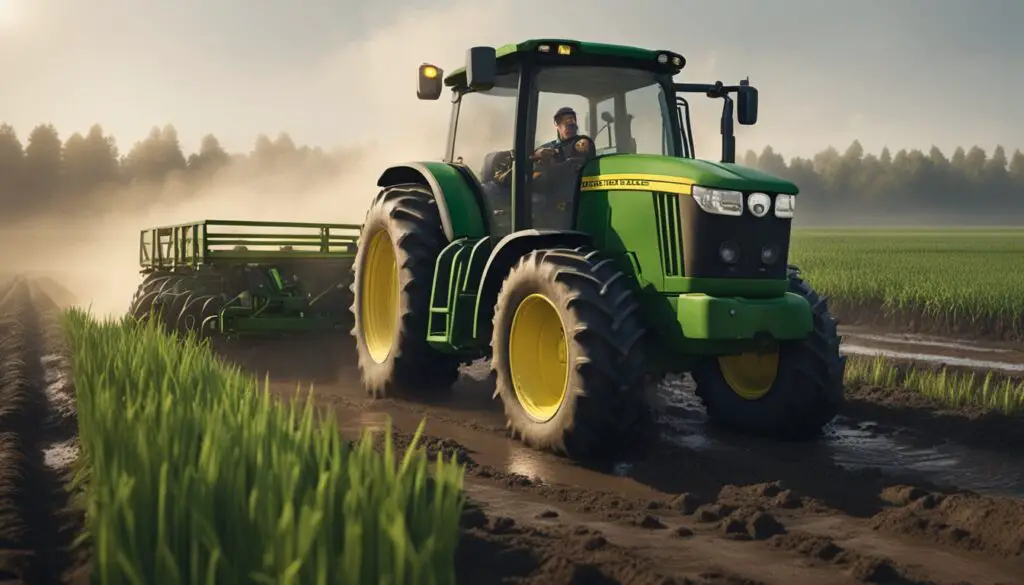
Understanding the intricacies of your John Deere 5065E is crucial as it can help you swiftly deal with any difficulties that might arise. Issues can range from electrical difficulties that impact starting and performance to transmission challenges which might affect the tractor’s operation. Equally important are the fuel system and consumption, along with the cooling and lubrication processes that keep your tractor running smoothly. A solid grasp of diagnostic procedures and routine maintenance will preserve the tractor’s reliability and your safety while operating the equipment.
Key Takeaways
- Familiarizing yourself with common tractor problems can enhance operational efficiency.
- Effective troubleshooting and regular maintenance are vital for tractor longevity.
- Prioritize safety measures and comfort to ensure a better operating experience.
Overview of the John Deere 5065E
Your John Deere 5065E stands as a testament to the enduring quality that John Deere is known for, offering a balance between compact size and versatile utility. This tractor is tailored to meet the needs of farmers looking for a machine with sufficient horsepower for a variety of tasks.
Features of 5065E
- Horsepower: With 65 horsepower, the 5065E is powerful enough to handle tasks ranging from plowing to planting.
- Capacity:
- Fuel: It has an 18-gallon fuel capacity, ensuring long work periods without the need for frequent refueling.
- Hydraulics: The 2WD variant comes with a 10-gallon hydraulic system, while the 4WD variant is equipped with a 10.3-gallon system, and the front axle holds 4.8 quarts.
- Size: Its compact size makes it ideal for maneuvering in smaller spaces or between tight rows.
- Utility: As part of John Deere’s utility tractor series, it’s designed to be versatile, adaptable to various farming operations.
Comparison With Other Tractors
When comparing the 5065E to other tractors, such as the slightly more powerful John Deere 5085, it’s essential to consider your requirements for horsepower and size. Different brands may offer similar compact utility tractors, but John Deere’s reputation for reliability often sets it apart. Remember to assess factors like:
- Capabilities: Does the tractor meet the specific demands of your farmwork?
- Size and Maneuverability: How does the tractor’s size influence your ability to work effectively on your land?
- Horsepower Needs: Is the horsepower suitable for your farming operations compared to other models?
Recognizing Common Problems
When you’re working with a John Deere 5065E, being familiar with common issues can help you address them quickly. This section will guide you through identifying frequent problems with the engine and hydraulic system.
Engine Issues
Your John Deere 5065E might experience engine stalling or overheating under certain conditions. If your tractor stops running unexpectedly, this might be due to contaminated fuel filters or a malfunctioning fuel system. To diagnose engine stalling, check the fuel filters and the air intake system for blockages.
- Stalling: If your tractor’s engine cuts out under minimal load, investigate the fuel filters first.
- Overheating: Ensure that the coolant levels are adequate and look for any leaks. Regular maintenance can prevent these issues from arising.
Hydraulic System Faults
Hydraulic problems in your John Deere 5065E can manifest in various ways, such as difficulty steering or operating the lift. A common sign is erratic movement or a total failure of hydraulic components. To troubleshoot:
- Lack of Response: Check the hydraulic fluid level and quality.
- Weak Operation: Inspect for leaks in the hydraulic lines and ensure the hydraulic pump is functioning correctly.
Electrical and Transmission Challenges
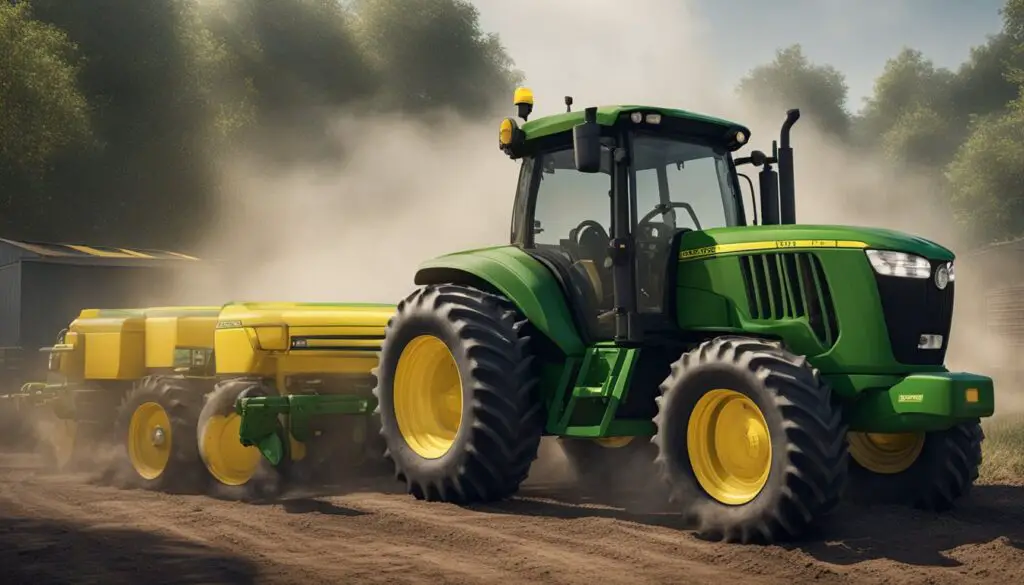
When you’re dealing with a John Deere 5065E, it’s crucial to be aware of certain electrical and transmission challenges that can arise. Your vigilance ensures your tractor performs optimally, especially in terms of battery health and transmission functionality.
Battery and Wiring Concerns
Your tractor’s battery and wiring are fundamental to starting the engine and powering electrical components. If you encounter issues like the tractor not starting, no dashboard lights, and gauges not functioning, here are some steps to effectively address these issues:
- Check the Battery: Ensure that the terminals are clean and secure. A multimeter can help verify the battery’s voltage, which should read around 12.6 volts when fully charged.
- Examine Wiring Connections: Look for signs of wear, corrosion, or damage in the wiring. Use a digital multimeter to check for continuity in the fuseable links and other critical circuits.
- Inspect Sensors and Indicators: Faulty sensors or indicators could mislead your diagnostics. Ensure that all sensors are functioning correctly, as they can affect the electrical system.
Power Reverser and Transmission Glitches
Transmission problems, particularly with the Power Reverser, can manifest in several ways:
- Shifting Difficulties: If you’re having trouble shifting, it may be due to cable misadjustment or linkage issues. Adjust or replace the cables if the clutch pedal feels loose or the shifting is not smooth.
- Transmission Sensors: Keep an eye on performance indicators and sensors. They can provide early warnings of transmission glitches. A professional diagnostic tool might be necessary to pinpoint specific issues.
By staying on top of these electrical and transmission challenges, you’ll help ensure that your John Deere 5065E tractor remains a reliable workhorse for your needs.
Fuel System and Consumption
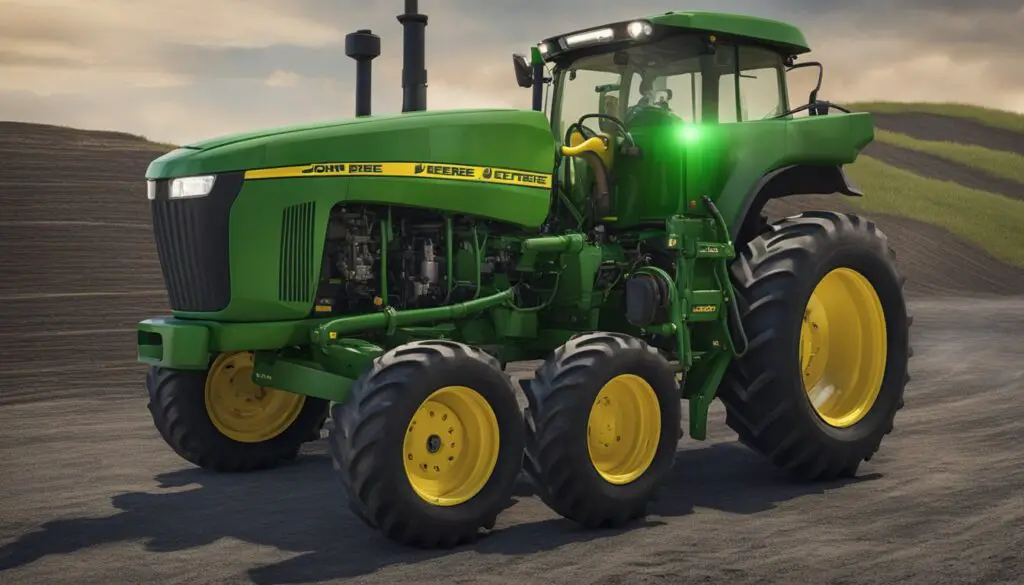
Your John Deere 5065E’s performance heavily depends on a well-maintained fuel system. Keeping an eye on fuel consumption and the quality of your fuel can prevent many common issues.
Fuel Filter Issues
The fuel filter is crucial for protecting your engine from impurities, and any clog can lead to many fuel problems. To keep your tractor running smoothly, regularly check and replace the fuel filter. If you face a starting issue or find your engine’s performance dipping, examine the fuel filter—it might just need a cleaning or replacing.
- Signs of Clogged Fuel Filter:
- Difficulty starting the engine
- Reduced engine power
- Unusual engine noises
- Quick Fixes:
- Inspect the fuel filter for blockages; if clogged, clean or replace it.
- Ensure the fuel line is not obstructed and is in good condition.
Optimizing Fuel Efficiency
For optimal fuel efficiency, make sure you’re using the correct type of fuel and consider adding a fuel stabilizer, especially if your tractor is not used regularly. Regularly inspect the fuel pump for any signs of wear or damage and replace it when necessary. Proper maintenance of your fuel system not only cuts down on fuel consumption but also prolongs the life of your engine.
- Tips for Better Fuel Efficiency:
- Use high-quality diesel fuel to protect your engine and ensure efficient combustion.
- Install a fuel stabilizer to preserve fuel quality during prolonged storage.
By attentive care to these areas of your John Deere 5065E’s fuel system and consumption, you can ensure your tractor runs efficiently and reliably. Remember, routine maintenance is the best prevention against fuel-related problems.
Cooling and Lubrication Processes
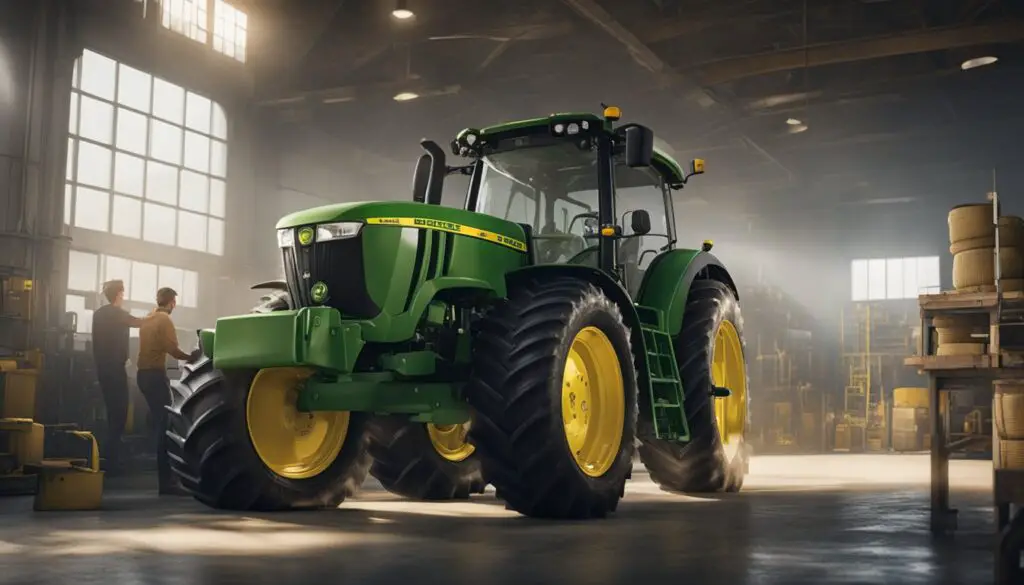
Your John Deere 5065E tractor relies heavily on its cooling and lubrication systems to operate smoothly. Managing engine temperature through the cooling system, and minimizing friction with proper lubrication, are essential to your tractor’s health and efficiency.
Dealing With Overheating
If your tractor is overheating, it’s crucial to inspect the cooling system for any signs of malfunction. The most common culprit is often the radiator – it should be free from blockages and leaks. To prevent overheating:
- Check coolant levels regularly and top up if necessary.
- Inspect the radiator for debris and clean it to ensure airflow isn’t restricted.
- Check for coolant leaks which could suggest a crack or hole in the cooling system components.
Overheating can sometimes be related to clutch problems where excessive friction generates extra heat, further straining the cooling system.
Maintaining Effective Lubrication
Proper lubrication reduces wear and tear by decreasing the friction in moving parts of your tractor. To maintain an effective lubrication system:
- Use the right oil as specified by the manufacturer for your tractor model.
- Regularly check oil levels; low oil can lead to increased engine wear and higher temperatures.
- Replace oil and filters as recommended by your service schedule to ensure consistent lubrication quality.
It’s essential to follow these guidelines to keep your tractor running effectively and prevent any potential issues related to the cooling and lubrication processes.
Diagnostic Procedures and Troubleshooting
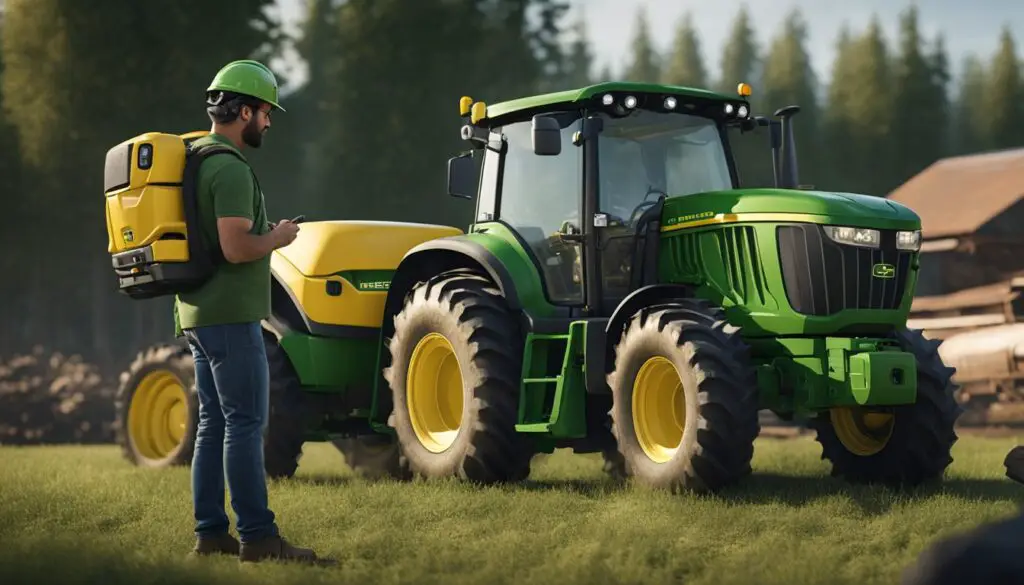
Before diving into repairs, it’s crucial to accurately diagnose issues with your John Deere 5065E. Utilizing the right diagnostic tools and following a structured troubleshooting guide will streamline the process of identifying and addressing problems.
Using Diagnostic Tools
Your first step in diagnosing issues with your John Deere 5065E is to use the appropriate diagnostic tools. A digital multimeter is invaluable for electrical diagnostics, allowing you to check the continuity and voltage of various electric components. For engine diagnostics, an OBD (On-Board Diagnostics) scanner can be used to read error codes which helps pinpoint specific malfunctions.
- Digital multimeter: Test switches and wiring for continuity.
- OBD scanner: Check for error codes related to engine issues.
Following a Troubleshooting Guide
A troubleshooting guide specifically crafted for the John Deere 5065E will be your roadmap for addressing common issues, each step guiding you through checks and fixes. Here is a basic framework:
- Identify Symptoms: Narrow down the problem based on what the tractor is exhibiting—be it clutch issues, hydraulic failures, or PTO (Power Take-Off) malfunctions.
- Consult Error Codes: If your diagnostic tool has identified any codes, match these with the guide to understand potential causes.
- Check Fluid Levels: Low or contaminated fluids often cause hydraulic and engine issues.
- Electrical Inspection: Use your multimeter to test battery voltage, fuses, and connections. Look for any worn or damaged wires.
- Component Checks: Inspect specific parts like injectors or hydraulic pumps for physical damage or performance issues.
Following these steps, you can methodically work through problems and apply the necessary solutions without unnecessary guesswork.
Routine Maintenance and Care
Proactive routine maintenance is pivotal in ensuring the longevity and efficiency of your John Deere 5065E tractor. Keeping an eye on the hydraulic fluid levels and staying on top of filter maintenance will help prevent many common issues.
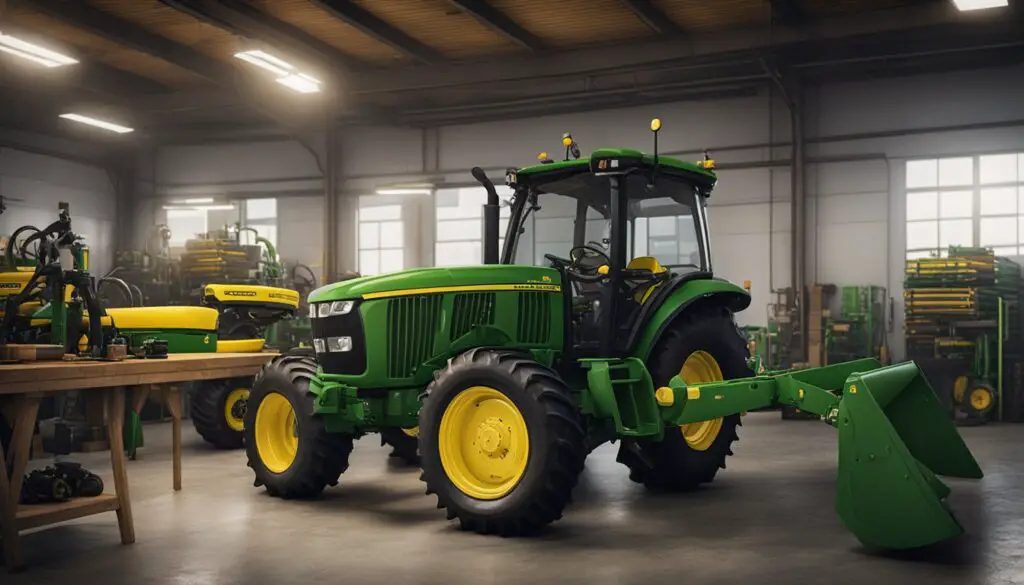
Checking Hydraulic Fluid Levels
To maintain your tractor’s hydraulic system properly, regularly check your hydraulic fluid level. For accuracy, ensure the tractor is on level ground and the engine is off before checking.
- Locate the hydraulic fluid dipstick, usually found at the rear-end or under the operator’s seat.
- Clean the area around the dipstick to prevent contamination.
- Remove the dipstick, wipe it clean, then reinsert it fully to check the level.
- The fluid should be between the add and full marks. If it’s low, add the recommended hydraulic fluid up to the correct level.
Note: Always use John Deere’s recommended hydraulic fluid to maintain system integrity.
Regular Maintenance of Filters and Hoses
Filters and hoses are critical to your tractor’s health. Regular inspections and replacements ensure that your tractor’s engine and hydraulic systems remain free from contaminants.
- Air Filters:
- Check air filter condition every 50 hours of use.
- Replace the air filter if you notice any damage or excessive dirt buildup.
- Part number: Refer to your tractor’s manual for the exact part number.
- Fuel Filters:
- Replace fuel filters every 400 hours or as indicated by signs of clogging.
- A clogged fuel filter can lead to engine performance issues.
- Hoses:
- Inspect all visible hoses for cracks or wear.
- Tighten connections if there’s evidence of leaks.
- Replace hoses that show signs of degradation to prevent failures in the hydraulic system.
Consistency in performing these maintenance tasks will not only keep your tractor running smoothly but also preempt costly repairs down the line. Remember, your John Deere 5065E tractor is a substantial investment; regular care is the key to getting the best return on it.
Operator Comfort and Safety
When operating your John Deere 5065E, it’s crucial to be familiar with the features of the operator station and understand the importance of safety indicators for a comfortable and secure experience.
Features of the Operator Station
Your comfort in the operator station is a priority. The 5065E typically comes equipped with features designed to enhance operator ease:
- Ergonomic controls: Strategically placed for easy access and minimal strain.
- Adjustable seat: Customizable positioning to suit your body type and preferences.
- Visibility: Ample glass and accessible mirrors for a clear view of your surroundings.
These thoughtful inclusions aim to reduce fatigue and increase your efficiency while working.
Importance of Safety Indicators
Safety is paramount, and your John Deere 5065E won’t let you forget it. Safety indicators in the cab are not just lights; they’re crucial communication tools:
| Indicator | Importance |
|---|---|
| Overheat light | Alerts you to potential engine overheating, preventing damage. |
| Oil pressure light | Indicates low oil pressure to prevent engine wear or failure. |
| PTO warning light | Ensures you’re aware when PTO is operating to prevent accidents. |
These indicators help you monitor the tractor’s condition and take timely action to minimize risks.
Frequently Asked Questions
In this section, you’ll find targeted answers to some of the most common concerns you might encounter with your John Deere 5065E. Whether it’s power reverser troubles or engine performance issues, we’ve got insights that can help steer you in the right direction.
What are common issues with the power reverser on a John Deere 5065E?
The power reverser on your 5065E might face issues like delayed response or difficulty changing gears. This could stem from low transmission fluid or a faulty solenoid.
Are there any recurring electrical problems in the 2021 John Deere 5065E model?
Yes, the 2021 model may experience electrical issues, such as faulty sensors or wiring problems, which could affect the tractor’s instrumentation or operation.
How can I troubleshoot hydraulic problems in the John Deere 5065E?
To troubleshoot hydraulic issues in your 5065E, check for leaks, ensure that the hydraulic fluid is at the correct level, and examine the condition of the hydraulic pump and filters for any signs of wear or damage.
What are some steps to resolve fuel system issues in a John Deere 5065E?
For fuel system problems, make sure to inspect and clean the fuel filters, check for blockages in fuel lines, and verify that the fuel injectors are functioning properly.
Can you provide tips for maintaining the transmission on a John Deere 5065E to prevent common problems?
Regularly check the transmission fluid level and quality, and replace it according to the service intervals. Also, look out for unusual noises, which could indicate wear and require professional inspection.
What should I check if my John Deere 5065E is experiencing power loss or engine performance issues?
If you’re noticing power loss, investigate the air intake for blockages, inspect the fuel system for clogs or dirty filters, and ensure the engine oil is clean and at the proper level.

Leave a Reply